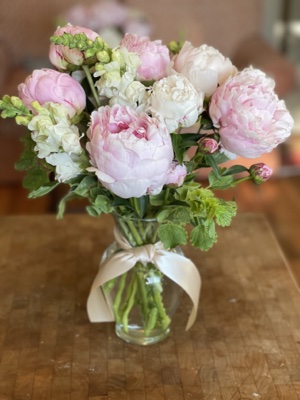Peonies in the garden
Welcome to Our Peony Paradise! Explore the enchanting world of peonies, perennial favorites cherished for their breathtaking blooms and timeless elegance. In this comprehensive guide, we’ll uncover the botanical wonders of peonies, from their origins to practical care tips, ensuring you have all you need to cultivate these floral treasures in your own garden.
Peonies: The Botanical Elegance
Common Name: Peony
Scientific Name: Paeonia
Family: Paeoniaceae
Peonies belong to the Paeonia genus and are cherished for their lush, fragrant blossoms. With origins in Asia, Europe, and North America, these perennial plants have captivated garden enthusiasts for centuries.
Unveiling the History of Peonies
Ancient Origins Peonies (Paeonia) boast a rich history that dates back thousands of years. Originating in Asia, particularly China, these perennial beauties found their place in ancient gardens, adorning imperial landscapes and becoming symbolic in various cultural contexts.
Cultural Significance In Chinese culture, the peony has long been revered as the “King of Flowers” and holds deep cultural significance. It symbolizes wealth, honor, and prosperity, often depicted in art, literature, and traditional ceremonies.
Migration to Europe The peony made its journey to Europe via trade routes, capturing the attention of botanists and horticulturists. Introduced to the West during the Middle Ages, peonies quickly gained popularity for their stunning blossoms and were cultivated in European gardens for both ornamental and medicinal purposes.
Medicinal Uses Beyond their aesthetic appeal, peonies were valued for their medicinal properties in ancient times. In traditional Chinese medicine, various parts of the peony plant were used to address ailments ranging from pain relief to promoting circulation.
Varieties of Peonies
A Palette of Peony Perfection
Discover the diverse world of peonies, including:
- Herbaceous Peonies: Soft, herbaceous stems and a variety of colors.
- Tree Peonies: Woody stems and a tree-like growth habit, offering extravagant blooms.
- Intersectional Peonies (Itoh Peonies): Hybrid varieties combining robust flowers with herbaceous growth.
Peony Palette: A Symphony of Colors
Peonies, those perennial treasures, paint gardens with a vibrant palette of colors, creating a symphony of hues that elevates any landscape. Imagine the soft and delicate allure of blush pink blossoms, exuding a romantic charm, or the bold and striking statement made by crimson red peonies. Pure and elegant, snow white peonies symbolize purity and grace, while sunny yellow blooms radiate cheerfulness. A blend of pink and orange, coral charm peonies bring warmth and vibrancy, while lavender varieties provide a subtle and soothing touch. Deep and sophisticated, rich burgundy peonies exude opulence, and creamy white blossoms offer a softer alternative. Vibrant and golden, golden yellow peonies brighten any garden, and bicolor marvels create a visually stunning effect with their captivating mix of two complementary colors. This diverse color range transforms the peony into a captivating botanical spectacle, making it a perennial favorite among garden enthusiasts.
Popular Varieties
- Sarah Bernhardt: A classic pink double peony, known for its abundant petals and delightful fragrance.
- Festiva Maxima: A timeless white peony with a crimson center, cherished for its beauty and resilience.
- Coral Sunset: A stunning coral-peach hybrid, captivating with its unique color and sturdy blooms.
- Bowl of Beauty: A striking pink and white Japanese-style peony, admired for its intricate petal arrangement.
- Kansas: A deep red peony with robust blooms, Kansas is a garden favorite for its rich color.
- Duchesse de Nemours: A pristine white peony with a hint of cream, loved for its timeless elegance.
- Bartzella: A yellow Itoh peony, Bartzella features large, fragrant blooms and a vigorous growth habit.
- Raspberry Sundae: A charming pink and white peony resembling an ice cream treat, adding a playful touch to gardens.
- Shirley Temple: A lovely blush pink peony with a hint of cream, known for its delicate and refined appearance.
- Karl Rosenfield: A classic dark red peony with full, double blooms, celebrated for its bold and enduring beauty.
Explore these peony varieties to create a captivating tapestry of colors in your garden, bringing forth the timeless allure of this beloved perennial.
Planting and Growing Peonies
Peonies can be grown in a variety of USDA hardiness zones, making them adaptable to different climates. Generally, peonies thrive in zones 3 to 8, but specific varieties may have different preferences. Here’s a breakdown:
- Zone 3: Suitable for colder climates with minimum temperatures ranging from -40 to -30 degrees Fahrenheit.
- Zone 4: Ideal for cold winter climates with minimum temperatures ranging from -30 to -20 degrees Fahrenheit.
- Zones 5 to 8: Gradually warmer climates, with zone 8 experiencing milder winters.
It’s important to consider the specific requirements of the peony variety you choose and ensure it aligns with the conditions of your gardening zone. Additionally, providing well-drained soil, adequate sunlight, and proper care contribute to the success of peony cultivation in various zones.
Cultivating Elegance in Your Garden
- Sunlight: Thriving in full sun but tolerant of partial shade.
- Soil: Well-drained, fertile soil is essential for optimal growth.
- Planting: Set peony tubers with eyes (buds) facing upwards, avoiding excessive depth.
Caring for Your Peonies
Nurturing the Ephemeral Beauties
- Watering: Provide consistent moisture, especially during dry spells.
- Fertilizing: Apply a balanced, slow-release fertilizer in early spring.
- Support: Stake taller peony varieties to prevent drooping under the weight of blossoms.
Benefits and Uses
Beyond Beauty: Practical Peony Applications
- Cut Flowers: Stunning, long-lasting blooms for exquisite arrangements.
- Landscaping Focal Points: Create garden focal points with bold, voluminous blooms.
- Symbolism: Peonies symbolize prosperity and good fortune, adding cultural significance to your garden.
Potential Challenges with Peonies
Tending to Peony Predicaments
- Ants on Buds: Ants are attracted to peony buds but do not harm the plant; a gentle shake or spray of water can remove them.
- Botrytis Blight: Ensure good air circulation to prevent this fungal disease.
Conclusion
Embrace the Allure of Peonies in Your Garden! Whether you’re a seasoned gardener or a novice, peonies offer a timeless allure that enhances any garden landscape. Enjoy the fleeting beauty and enduring elegance of these captivating blooms.
Frequently Asked Questions About Peonies
- What are Peonies? Peonies are perennial flowering plants known for their large, fragrant blossoms and lush, bushy foliage.
- What Types of Peonies Exist? The main types include herbaceous peonies, tree peonies, and intersectional (Itoh) peonies.
- How Do I Plant Peonies? Plant peonies in well-drained soil with eyes (buds) facing upwards. Ensure proper spacing and avoid planting too deep.
- When Do Peonies Bloom? Peonies typically bloom in late spring to early summer, depending on the variety and local climate.
- How Long Do Peonies Live? With proper care, peonies can live for decades, becoming more robust and producing more blooms over time.
- Do Peonies Attract Ants? While ants may be present on peony buds, they do not harm the plant. A simple shake or rinse can remove them.
- Can I Grow Peonies in Containers? Yes, you can grow smaller peony varieties in containers, providing they have sufficient space and drainage.
- How Do I Prevent Diseases in Peonies? Ensure good air circulation around peony plants to prevent fungal diseases like botrytis blight.
- Do Peonies Require Support? Taller peony varieties may benefit from staking to support the weight of their blossoms.
- Can I Use Peonies as Cut Flowers? Absolutely! Peonies make exquisite cut flowers, adding elegance to floral arrangements.
- What Cultural Significance Do Peonies Hold? Peonies symbolize prosperity and good fortune in various cultures, making them meaningful additions to gardens.
- How Should I Water Peonies? Provide consistent moisture, especially during dry spells, to ensure healthy peony growth.
- Do Peonies Need Full Sun? While they prefer full sun, peonies can tolerate partial shade, especially in warmer climates.
- Can I Plant Peonies with Other Flowers? Peonies complement various flowers and can be planted alongside other perennials for a diverse garden display.
Recent Posts

The Advantages of Built-Up Garden Beds: A Gardener’s Best Friend

The Secret Weapon for Lush Blooms: How to Create the Perfect Fertilizer Schedule

Create a Stunning Cottage Garden with These Easy-to-Grow Flowers

Fastest Growing Trees: Transform Your Landscape Quickly

What to Plant in July: A Comprehensive Guide for Gardeners












You must be logged in to post a comment.